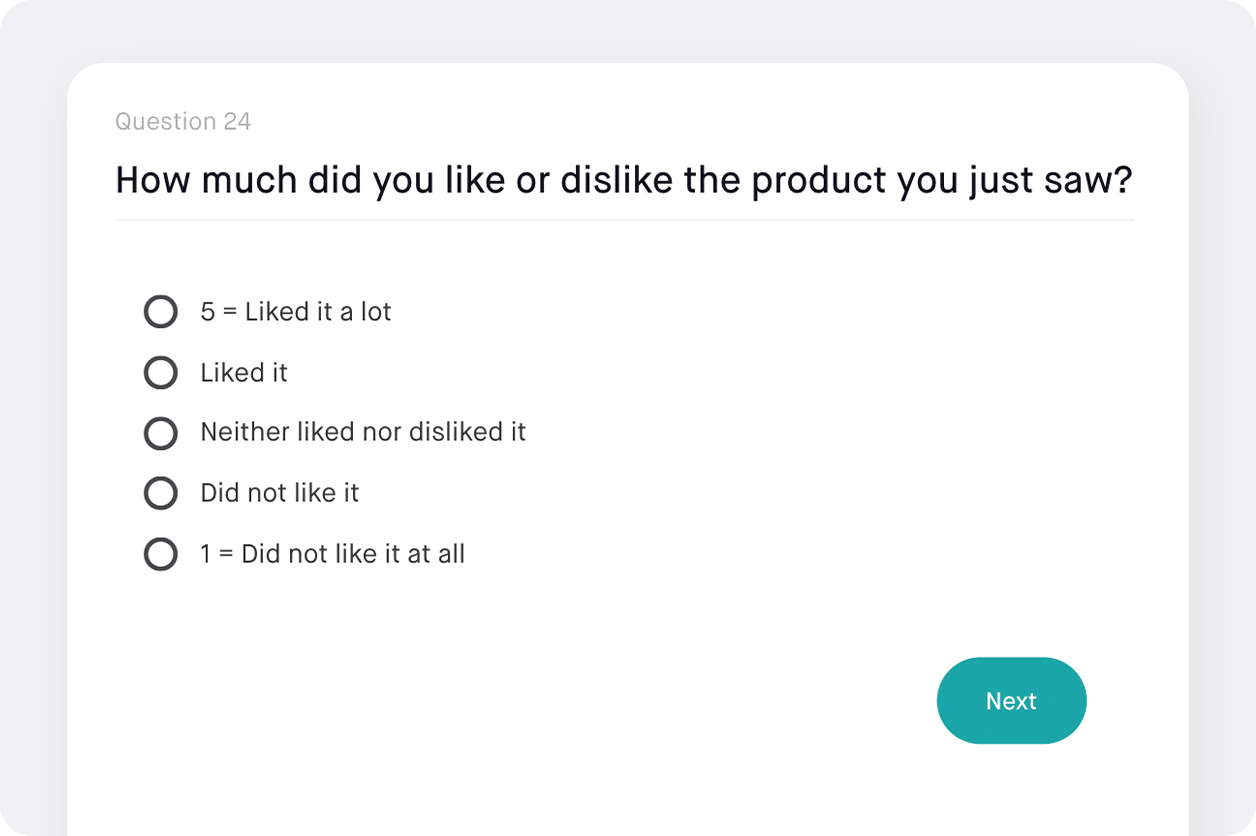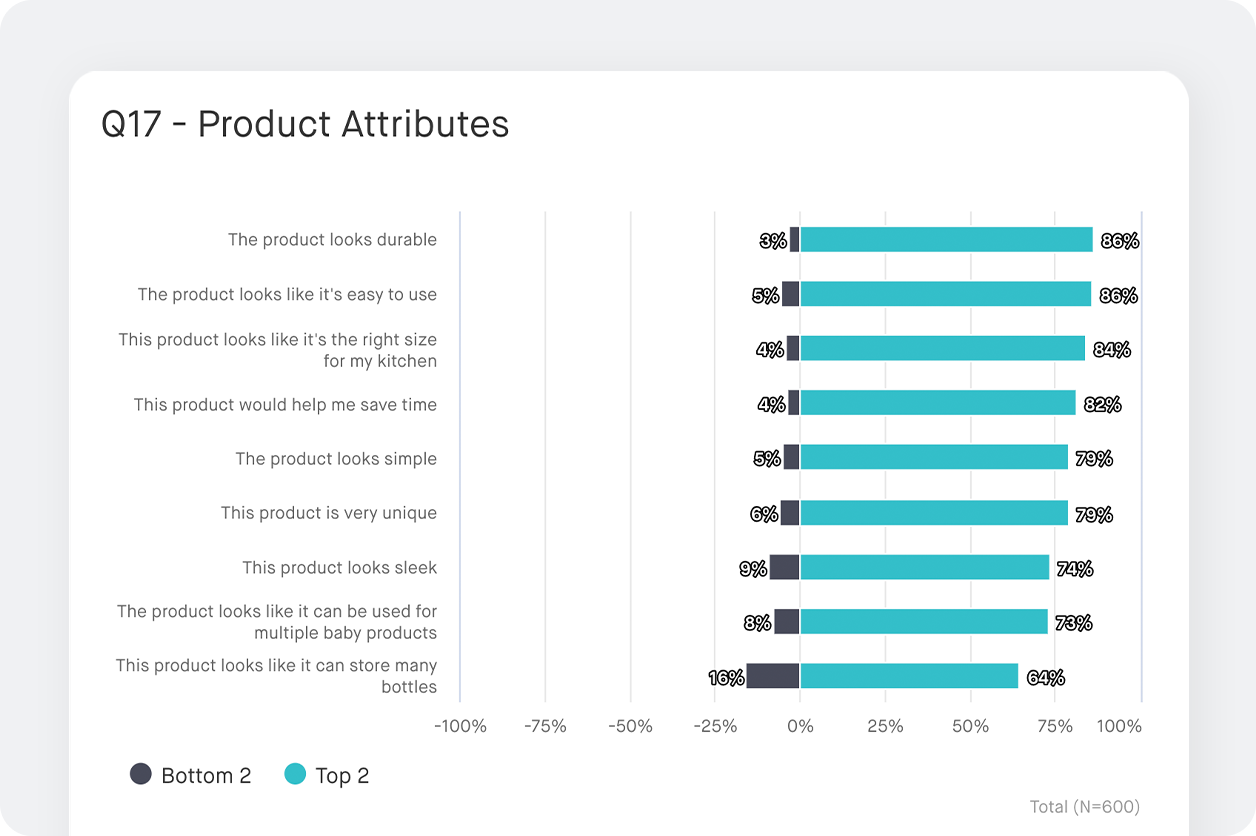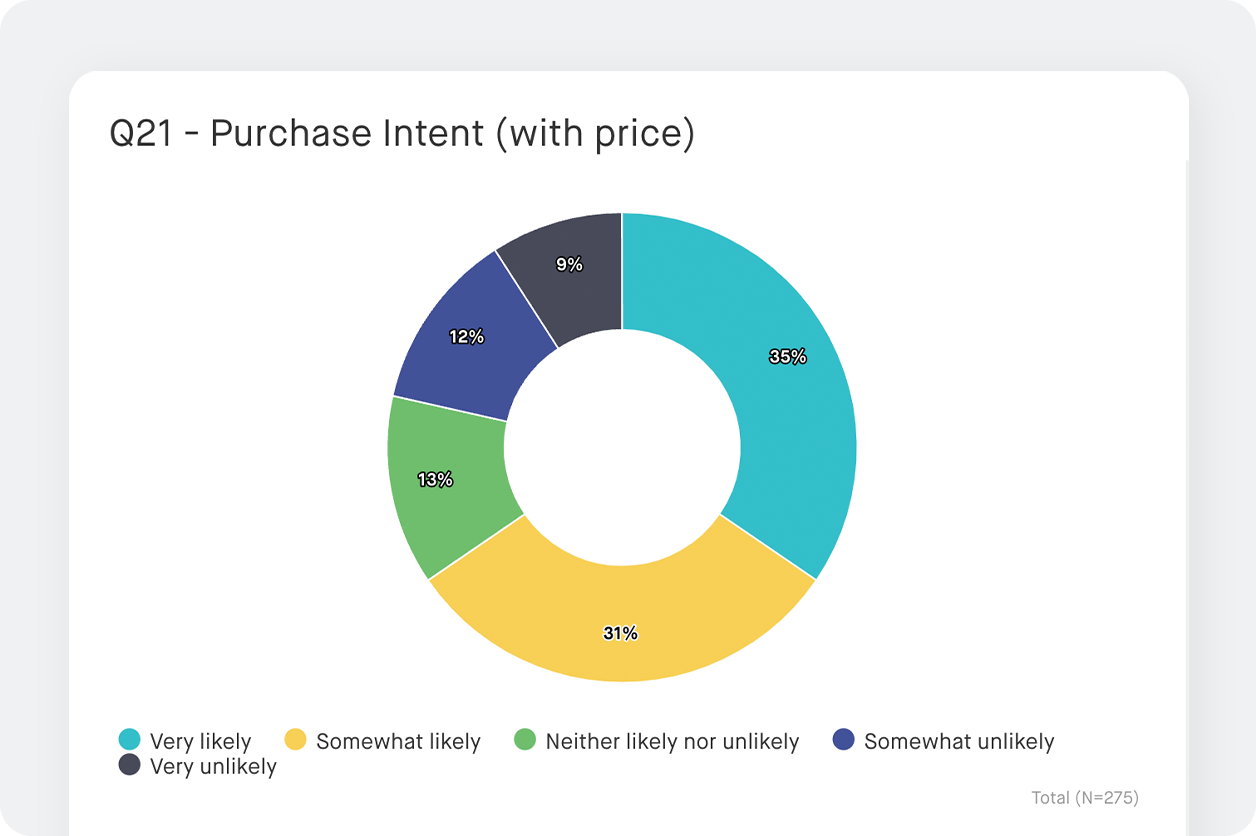Inform concept development
What do consumers think about potential products you're developing?
Concept testing in new product development helps to refine your concepts, make adjustments, and re-test your concept ideas before committing valuable resources.

Understand concept usage
How will consumers use your concepts?
Ask concept testing questions to learn how consumers will use your products; this information can guide the development of features, flavors, packaging types, and other aspects of your product.

Tailor packaging concepts
What do consumers think about your packaging concept?
Use online concept testing to identify which colors, logo designs, materials, and other packaging aspects consumers gravitate toward.

Price out your concepts
What do consumers think of the proposed pricing for your concepts?
Use concept testing methods to uncover pricing perceptions - such as what prices consumers consider too cheap or too expensive, or how much price impacts consumers' purchasing decisions.

Automated advanced methods for a concept study:
Concept projects with quantilope
Leverage quantilope as a concept testing platform to make faster decisions through market research automation
Gain concept validation with high-quality, advanced method findings
Use data-backed insights to make better-informed concept decisions
Lean on support from quantilope’s classically-trained research consulting team
"quantilope accompanied us from the first rough idea to the marketable product. Therefore, the product development was goal-oriented and much faster than we expected. We had the results for each step after 1-2 days."
- Ole Strohschnieder, Founder and CMO

Frequently Asked Questions:
What is concept testing?
Concept testing is a research methodology that evaluates consumer reactions to new product or service ideas before full development and market launch.
This research approach helps brands gauge interest, identify potential issues, and optimize their concepts based on direct consumer feedback. quantilope's concept testing platform allows you to test anything from product features and packaging designs to marketing messages and pricing strategies.
By gathering consumer insights early in the development process, concept testing significantly reduces the risk of market failure and helps allocate resources more effectively toward ideas with the highest potential for success.
What features should I look for in a concept testing platform?
When selecting a concept testing platform, prioritize these key features that drive research efficiency and insight quality:
First, look for automation capabilities that streamline the entire research process—from survey design and fieldwork to analysis and reporting. A platform with advanced methods like Conjoint, MaxDiff, and A/B testing will provide deeper insights than basic survey tools.
Real-time data visualization is essential for making quick decisions, so choose a platform with interactive dashboards that update as responses come in. Built-in statistical testing is another helpful tool that automatically highlights significant differences in your data.
Finally, ensure the platform offers flexibility to test various concept elements—from product features to pricing and packaging—with easy iteration capabilities to refine concepts based on initial feedback.
What are the steps of concept testing?
Effective concept testing follows a structured approach to gather meaningful consumer feedback:
Begin by clearly defining your objectives—understanding exactly what you need to learn about your concept and how you'll use the insights. Next, develop your concept stimuli, whether through descriptions, images, videos, or prototypes that effectively communicate your idea.
Select appropriate research methods based on what you're testing. A/B testing is ideal for comparing two versions of a concept, while Conjoint analysis helps optimize feature combinations and MaxDiff analysis prioritizes concept elements.
Design your questionnaire to capture key metrics like appeal, uniqueness, purchase intent, and pricing perceptions. After collecting data from your target audience, analyze results to identify strengths, weaknesses, and optimization opportunities.
Finally, implement changes based on consumer feedback and consider re-testing the improved concepts to validate your adjustments.
How can a concept testing platform help in evaluating new product ideas?
A concept testing platform transforms the evaluation of new product ideas from subjective guesswork into data-driven decision making in several key ways:
It provides objective consumer feedback that helps separate promising ideas from those likely to fail in the market. By quantifying metrics like purchase intent, uniqueness, and relevance, you gain clarity on which concepts have genuine market potential.
quantilope's platform enables you to test multiple concept variations efficiently, identifying which specific features or attributes drive consumer interest through methods like Conjoint analysis and MaxDiff analysis.
With quantilope's automated insights, you can rapidly iterate and refine concepts based on consumer feedback. This significantly reduces time-to-market while simultaneously increasing confidence that your final product will meet consumer expectations.
What is an example of concept testing?
A classic example of concept testing involves a beverage company developing a new energy drink with unique flavor profiles and functional benefits.
Using quantilope's platform, they first conduct idea screening to evaluate multiple flavor and benefit combinations. Based on these initial insights, they develop several promising concept variations—each with different positioning around natural ingredients, energy boost longevity, and flavor intensity.
Through monadic testing, different consumer groups see each concept in isolation, measuring appeal, purchase intent, and perceived value. A MaxDiff exercise reveals which benefits are most compelling, while Van Westendorp pricing research identifies optimal price points.
The company then refines their leading concept based on this feedback (e.g., adjusting flavor intensity and messaging around natural ingredients) before finalizing their product for market launch with confidence in its consumer appeal.
How does concept testing improve product development?
Concept testing transforms product development from an internally-driven process to one guided by consumer preferences at every stage:
Early in development, it helps teams prioritize which concepts deserve further investment, saving resources that might otherwise be wasted on ideas with limited market appeal. This concept validation provides business leaders with confidence to proceed with promising ideas while quickly eliminating underperforming ones.
During product refinement stages, concept testing identifies specific features and attributes consumers value most, helping teams focus on improving elements that drive purchase decisions rather than adding features that may go unappreciated.
Prior to launch, it reduces risk by confirming market readiness and optimal positioning, while also informing pricing strategies through methods like Van Westendorp or Conjoint pricing analysis.
By integrating consumer feedback throughout development, products enter the market with higher confidence in their success and fewer expensive post-launch adjustments.
What is a commonly used method for concept testing?
A/B testing (also called monadic testing) is one of the most commonly used methods for concept testing due to its effectiveness, clarity, and versatility.
This approach involves showing different groups of consumers different concept versions, with each respondent seeing only one concept for unbiased feedback (i.e., no comparison between concepts). quantilope automates monadic A/B testing, making it easy to detect statistically significant differences between concept variations.
For more complex product development challenges, Choice-Based Conjoint is increasingly popular as it simulates realistic consumer decision-making by having respondents choose between different feature combinations. This reveals which specific elements drive preference and how consumers make tradeoffs between different attributes (the same way they do when shopping in a store).
Both methods provide actionable insights that directly inform concept refinement, with quantilope's platform making these advanced techniques accessible without specialized expertise.
Request an automated Concept demo now!


